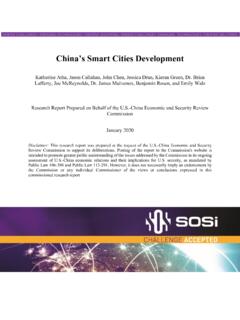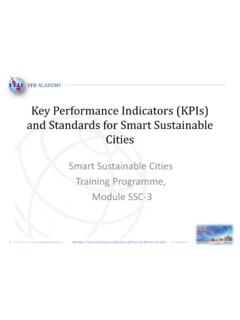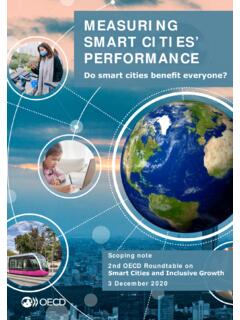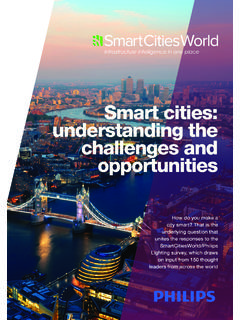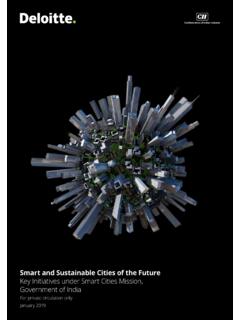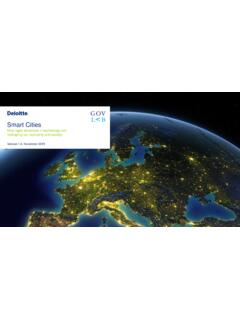Transcription of The Fourth Industrial Revolution Combatting COVID-19: The ...
1 Expert Group Meeting on Socially just transition towards sustainable development : The role of digital technologies on social development and well-being of all UNDESA / Division for Inclusive Social development , in collaboration with UNCTAD and ITU, 4-7 August, 2020. 1 The Fourth Industrial Revolution Combatting COVID-19: The Role of smart and Sustainable cities Dr. Maysoun Ibrahim Ramallah, State of Palestine 1. Introduction cities around the globe are facing an unprecedented urbanization growth, which is expected to reach around 65% to 75% of the total world s population by 2050 (UN, 2014). The latter sets off the wave for the revitalization and expansion of existing cities and the development and creation of new ones.
2 To meet this, cities need a new operating paradigm that is able to provide the solutions required by urban residents. These solutions should be economically viable, environmentally sustainable, and socially inclusive. Economically viable refers to solutions that are financially self-sustaining while environmental sustainability aims at ensuring the protection of current resources for future generations. By social inclusion, the access to benefits is equitable across population segments without any discrimination (Ibrahim et al., 2017; PwC, 2010). On one hand, the concept of smart and Sustainable City (SSC) emerged recently as a solution for various current urban problems with the aim of improving the quality of life of citizens and enhancing the sustainability issues of cities .
3 It is getting global attention rapidly as a desired goal for present and future urban development (PwC, 2015; ITU-T FG-SSC, 2016). As a result, many governments and city planners started to recognize the role of Information and Communication Technologies (ICTs) in meeting these objectives. In this context, the ICT components are used as an enabler in designing cities to be smarter and more sustainable, offering better quality of life through environmentally friendly and viable solutions (Ibrahim et al., 2015). On the other hand, specifically in 2015, Klaus Schwab introduced the phrase the Fourth Industrial Revolution in an article in the Foreign Affairs Magazine.
4 On January 2016, the theme of the World Economic Forum Annual Meeting in Davos-Klosters, Switzerland was titled as Mastering the Fourth Industrial Revolution (WEF, 2016). From this date on, the world started the era of the Fourth Industrial Resolution (Industry or 4IR). A SSC City is defined by the International Telecommunication Union of the United Nations (ITU-T FG-SSC 2014) as an innovative city that uses ICTs and other means to improve quality of life, efficiency of urban operation and services, and competitiveness, while ensuring that it meets the needs of present and future generations with respect to economic, social and environmental aspects as well as cultural aspects.
5 It is also defined by Giffinger et al., (2007) across six dimensions, namely, smart Economy (competitiveness), smart Environment (natural resources), smart Governance (participation), smart Living (quality of life), smart Mobility (transport and ICT), and smart People (social and human capital). In turn, the Fourth Industrial Revolution (4IR) is a digital Revolution enabled by the extraordinary technology advances of the previous Industrial revolutions. This era is characterized by a fusion of technologies that is blurring the boundaries and lines between the physical, digital, and biological worlds (WEF, 2016). It is a fusion of advances in data science, Artificial Intelligence (AI), drones, robotics, quantum computing, nanotechnology, biotechnology, Internet of Things (IoT), 3D printing, and other technologies.
6 In December 2019, the ongoing COVID-19, also known as coronavirus, started to outbreak in Wuhan city of China. In January 2020, the World Health Organization (WHO) declared this outbreak as a Public Health Emergency of International Concern and then considered it as a global pandemic in March 2020. This pandemic has caused confusion and disruption at the economic and social levels globally, forcing many governments to lockdown hundreds of cities around the world. Evolution of COVID-19 (coronavirus) pandemic has also resulted in strengthening the use of big technologies, especially, those related to Industry and SSCs. This pandemic increases the trust on ICT technologies as a tool that have the needed capabilities to support the public health as well as to provide quick solutions to many governments, organizations, and people during the time of crisis.
7 2. cities and COVID-19 (Coronavirus) cities around the globe are affected by the outbreak of COVID-19 (coronavirus), risking not only the public health, but also endangering the national and global economy and the fabric of societies. Because of COVID-19, many national and local governments around the world are currently confronting weak and strained financial resources. This is due to the decline in tourism revenues, lower exports, and economic activities' acute contraction. Unfortunately, this virus has a deep, multidimensional impact on people and cities . It forces authorities worldwide to implement a series of actions aiming at reducing its impacts, including lockdowns, travel restrictions, facility closures, distance learning, working from home, and workplace hazard controls.
8 As a result, it is expected from COVID-19 (coronavirus) to create the worst economic contraction in decades, including hundreds of thousands of job losses. cities and other urban settlements with a robust governance and a strong healthcare infrastructure are in a better position than others (WEF, 2020). Not surprisingly, cities that already started their transformation process to be smart and sustainable have been able to control the outbreak of COVID-19 more than others, being better prepared for the possible future crises as well. During the pandemic time, such as Coivd-19, it is critical for cities to adopt a combination of a needed measures to prevent the spread of the pandemic such as the proactive surveillance, rapid isolation, and community and personal protection ( social distancing).
9 A SSC, as known, uses ICTs to streamline urban operations on a large scale. It uses sensors to collect the data needed to monitor and control traffic, noise, air quality, health among others to improve and support future decisions of authorities, enterprises, and people. It provides a digital integrated platform to create information and knowledge network that can be used, during the pandemic time, to monitor infected people while warning others. cities are the result of agglomeration of hard and soft infrastructures in addition to its ICT or digital infrastructure. These infrastructures are urban features that have been installed by human activities and are essential for a city to operate.
10 The hard infrastructure refers to the tangible ( physical) structures such as buildings, roads, pipes, wires, shared spaces, bridges, and ports. The soft infrastructure, in turn, refers to the intangible structures such as laws, regulations, rules, conventions, financial systems, government systems, healthcare systems, education systems, human capital, business environments, and others (Pincetl, 2015; Anderton, 2016). These two structures are completing each other. For instance, an airport as a hard infrastructure of a city cannot function without a set of soft infrastructures that provides a list of rules about the minimum acceptable size of runways, required distance between landing and taking off planes, conventions regarding passenger loading and unloading, and so on (Pincetl, 2015).










